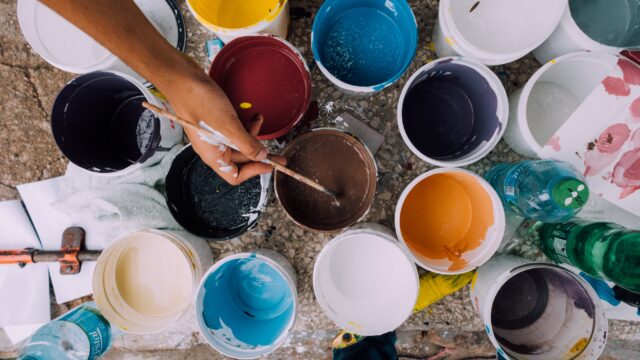Dear readers,
This December marked my five-year anniversary of living off-grid on three acres of tropical rainforest in rural Hawaii. It’s the longest relationship I’ve had with a place since leaving my parents' house at seventeen, and the first time I’ve been solely responsible not only for maintaining a home, but for building one from the ground up—painting every board, laying every stone, and slowly coaxing the magic of running water and electricity out of previously-inscrutable piles of wire, fuses, and PVC pipes.
A few months ago, I decided to build a solid roof over my bed to replace the tent I had been sleeping in ever since I moved onto the land. I hauled in the lumber and hardware, and my next-door neighbor framed in a simple shoebox of a structure with a sturdy metal roof and half-walls on two sides to let in light and air. Over the holidays, I caulked and painted, stapled mosquito screens across the openings in the half-walls, and finally retrieved my grandmother’s painting from a friend’s house and hung it on the wall.
For most of the five years I’ve lived on my land, the infrastructure has been provisional and haphazard—temporary placeholders propping up yet more temporary placeholders. The kitchen sink is held up by two sawhorses, its faucet hooked up to a garden hose. A handful of nails banged into a two-by-four passes for a tool rack; a length of PVC pipe suspended between two hooks serves as a closet; a couple of old wooden boxes stacked one on top of the other functions as a staircase, provided you have good balance.
At the time that I put these things in place, they felt like amazing improvements: no more washing dishes in a five-gallon bucket, or storing clothes in garbage bags. Now, I am slowly replacing these resourceful but flimsy solutions with sturdier successors—overwriting my exuberant but sloppy first draft with something a little more elegant, sure-footed, and pleasant to behold.
Creativity takes many forms, but I’ve found it to be an essential practice to a happy and fulfilling life. And whether you’re building a homestead, choreographing a dance piece, establishing a spiritual practice, or writing a book, chances are you’re going to go through one or several first drafts before arriving at the final expression of your vision. Our early attempts are sometimes exuberant and bursting with beginner’s luck; other times, they’re halting and uncertain, bits and pieces coming together as we feel our way through the dark. We know there’s something juicy in there, and we have a feeling if we just try a little bit of this and a little bit of that, we can slowly summon it into existence. As a writer and editor, I am well-acquainted with first drafts with their endless placeholders and notes-to-self. Need better anecdote to illustrate this point, I’ll write. Or, End-of-chapter exercise will go here.
A first draft often looks like one long to-do list: Fix this! Replace that! See if this works better over there! You call your creative vision into being by sketching out what will be there someday, erecting a crude version of it as you go, while promising to eventually replace those preliminary gestures with the real thing. You dream, ruminate, and gather inspiration from others who have trodden a similar path—and you make endless lists of what you’ll do to make your creation even better.
Every now and then, a little piece of the final version will make itself known to you: a few paragraphs that just happened to come out right the first time, a chord progression you feel confident about, an aspect of your project that just makes sense. These moments of clarity offer a sneak preview of the polished gem to come, and often give us just enough encouragement to keep going through the more difficult aspects of the work. Starting at one of those solid points, you can slowly claim more and more territory, coaxing the rest of your creation into being.
Although the decisions involved in undertaking a creative project seem endless, an infinite fractal of possibilities that can easily overwhelm even a seasoned artist or creative, each new point of clarity helps to narrow those options down. Huge structural decisions give way to modest organizational ones, which in turn yield to subtler aesthetic ones. What was once an unwieldly and impossible jumble of ideas mysteriously transforms into a generous, coherent, and meaningful work of art; a contribution that might help, inspire, or even shelter someone, someday.
The platform on which my tent used to sit, and on which my shoebox now stands, was the first point of clarity in the process of drafting my homestead. When I first arrived on my land, I had no idea how long I would stay here, or what kind of shelter I’d need. All I knew was that I had to get above the thick brown mud that swallowed my boots to the ankle every time I took a step.
My need to be dry was so urgent that I couldn’t afford to spend weeks carefully evaluating where the platform should go. Instead, I picked a spot, cleared a few spindly guava trees that were standing in the way, and banged the thing together. As it so happens, I was lucky: the spot I chose has worked well over the years, the surrounding trees providing both privacy and shade.
Having just one permanent element of my homestead in place gave me an anchor point from which to build the rest. The overwhelming fractal of possibilities resolved itself into a somewhat smaller subset of options; I set about plotting other chapters, and sketching out where other elements of my homestead would go. Any visitor to the land could see that my vision was far from realized, the tarps and sawhorses dragged to more promising locations every month or so; yet every now and then, a new point of clarity would emerge, and like a constellation revealing itself amid the stars, the final shape of my home began to come through.
Now that the tent is gone, I am slowly replacing many of the other original features of my home: that ridiculous sink, those dangerous stairs. As I erase the exuberant, ramshackle, sometimes-bewildering traces of my first draft, I feel grateful for the way these things held space for the better versions to come. These structures didn’t come out perfectly the first time, and they didn’t need to—like the placeholders in a manuscript, their job was to say, Do this thing, but better; and by their mere existence, to give me the confidence that I could.
Few artists know exactly what they’re going to say when they pick up a paintbrush, tune their guitars, or sit down to write a book, but the process of creation teaches them. Following our creative passions challenges us to go beyond what we already know and become more capable than we already are. In our first drafts, we throw our intelligence into a kind of sandbox, saying, Go play, go try things! I trust that you’ll figure it out. Eventually, a handful of words becomes a song; a hazy vision becomes a clearly defined path, and a determined amateur becomes a knowledgeable practitioner.
When I decided to build the shoebox, I wondered if I would feel nostalgic for the tent which so defined my first five years on the land. But now that I’m sleeping under a solid roof, I’ve discovered that I feel no more nostalgic for the tent than for one of the many haphazard and provisional first drafts which have passed across my desk as a writer and editor. The books that emerged out of those drafts were far superior to the drafts themselves; and the shoebox is indisputably superior to the tent.
First drafts aren’t meant to be clung to. Like seedpods, they are meant to break down and fade away when the true flower emerges. We might look back fondly on planting those seeds, but we would never trade the flower to get the seed back again. Once they’ve served their purpose, first drafts disappear; it’s our job to let them go, even as we honor their role in bringing the final version to life.
In this new year, I look forward to keeping authors company as they transform their own first drafts into sturdy, beautiful, and worthy books. May your own seeds of inspiration receive the water they need to bloom—in whatever form your creativity takes—and may you perceive the potential in those first, uncertain gestures towards your vision, no matter how approximate they are.
Sincerely,
Hilary Smith
Senior Editor, Hierophant Publishing


